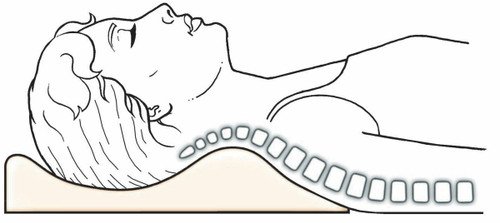Choosing the Right Pillow for You: A Guide for Better Sleep and Less Pain
Introduction:
As a Gonstead Chiropractic clinic, this is often the most asked question: What is the best pillow for my neck? Well, it all depends! Do you often wake up with a stiff neck or throbbing headache? If so, your pillow might be the culprit. Finding the right pillow isn't just about comfort; it's about supporting your neck's health and ensuring a restful night's sleep. We spend a third of our lives in bed, so choosing the right pillow is crucial for your spine's health. In this guide, we'll delve into the essential considerations for selecting the perfect pillow tailored to your sleeping habits, whether you prefer lying on your back or side.
This is the side view of your neck. There is a natural curvature along the back of the neck marked in green. This is known as the “cervical lordosis”.
What position should I sleep in?
This is the most common question we get at Adapt Spine Centre when, but first we have to understand a little spinal anatomy. When looking at the side profile of the neck or cervical spine, there should be a natural forward curvature known as a “cervical lordosis”. This natural curve helps to support the nerves, soft tissue and spinal cord that the neck protects. When sleeping, it is crucial to support this natural curve in a neutral position when we decide on which position to sleep in. Let’s now discuss the pros and cons of each sleeping position:
Stomach sleepers:
When sleeping on your stomach, there is no way to maintain a neutral spine where the head and neck is not twisted to one direction or the other, we do need to breathe after all! Although this position is comfortable for a lot of people, most of this stems from unresolved lower back pain and stiffness, an inappropriate mattress for the spine, and a sense of comfort from pressure on the chest or stomach. This last point can be resolved simply with an ordinary pillow that can be hugged to apply pressure to the stomach and chest when sleeping on their side. Sorry stomach sleepers, this is not the best position for your neck!
Back Sleepers:
Having a hole in the pillow allows the head and neck to remain neutral while supporting the cervical lordosis in the neck with material that is not too soft, and not too stiff.
If you can’t do stomach sleeping, then that leads basically two options: back or side! Luckily these options are much better for the neck. If you are a back sleeper, you need a pillow that helps to support the cervical lordosis. If your pillow is too high, it will push your neck forward and flatten out the natural curve. This can often lead to stiffness, neck pain and headaches. The ideal pillow takes into consideration these curves by supporting the curve in the middle, but also allowing your head to drop back so that it does not push the rest of your head forward. The pillow should also be firm enough that the portion supporting the neck does not sink in, but also not so hard it is too uncomfortable, like sleeping on a rock. One example is the Tri-Core pillow by Core Products, as it checks the boxes. However, if you sleep on your side, you want to be sure to avoid the middle, as you don’t want your head to fall into the hole on your side. This position may be difficult for some patients to get used to; therefore, there is a learning period to become comfortable.
Side Sleepers:
Maintaining a neutral spine when sleeping on your side will prevent pain and kinks in the neck after a long nights rest.
For side sleepers, the challenge lies in keeping the head and neck aligned with the spine without sacrificing comfort. You don’t want a pillow that is too tall or too small, as either can cause your neck to arch sideways, and you definitely don’t want a hole in it! The key lies in the size of your shoulders. Depending on how broad or narrow they are, the height of your pillow will be determined. The first step is to measure the width of your shoulders with a measuring tape. Measure from the neck all the way to the end of your shoulder, and compare that with the height of the pillow. The next step is to check the stiffness of the material, and make sure it does not sink down too much when you lay your head on it, so opt for a more firm pillow. One example is the Pillow Cube, which was designed for side sleeping only.
What if I sleep on both my side and my back?
The Therapeutica pillow has a hole in the centre to allow your head to rest and a bump to support the cervical lordosis, and really high side bolsters to allow you to sleep on your side. Although it may take some practice, this is often the best of both worlds for people as it satisfies the requirements for your spinal health!
This is the most common for most people, as many of us move around at night! In this case, you need a pillow that can do both side sleeping and back sleeping. You need to have a hole in the centre to allow your cervical curve to be supported while on your back, but you also need to have a high pillow on the side to allow your shoulders to rest. One example is the Therapeutica pillow by Core Products. This pillow is the one our Gonstead chiropractor uses on a daily basis because you can choose the height of the side of the pillow and the firmness of the pillow to customize it to you! It does take some practice so that you don’t fall into the middle hole while you are on your side when moving around at night. While odd at first, many people find that sleeping with these pillows can help to increase their quality of sleep over time!
Conclusion:
When embarking on your pillow hunt to alleviate neck pain, sleep disturbances, and headaches, keep an eye out for the following features:
Determine your position: Understanding what position you predominantly sleep in will help you select the appropriate pillow type; as long as it is not on your stomach!
Material Matters: Make sure the pillow is not too soft that your head will sink down and have no support for your neck.
Size appropriately: Make sure that the size of the pillow is custom fit to you. Someone who is 120lbs and 250lbs can’t have the same pillow sized correctly!
Give it time: Many of these pillows will require a period of discomfort to get used to, often times this can lead to more discomfort temporarily. Give it time! Pillows are a deeply personal preference so it takes at least one to two weeks to determine if the pillow is the right fit for you.
Pillows are really important for your spinal health, however they are only one part of the puzzle. Your neck pain can also stem from misalignments and postures from previous accidents, injuries and repetitive stress. If not resolved, a pillow will not be the full solution. Please reach out to us and schedule a comprehensive examination with our Gonstead doctor to find your path to pain-free nights and an optimal spine!





